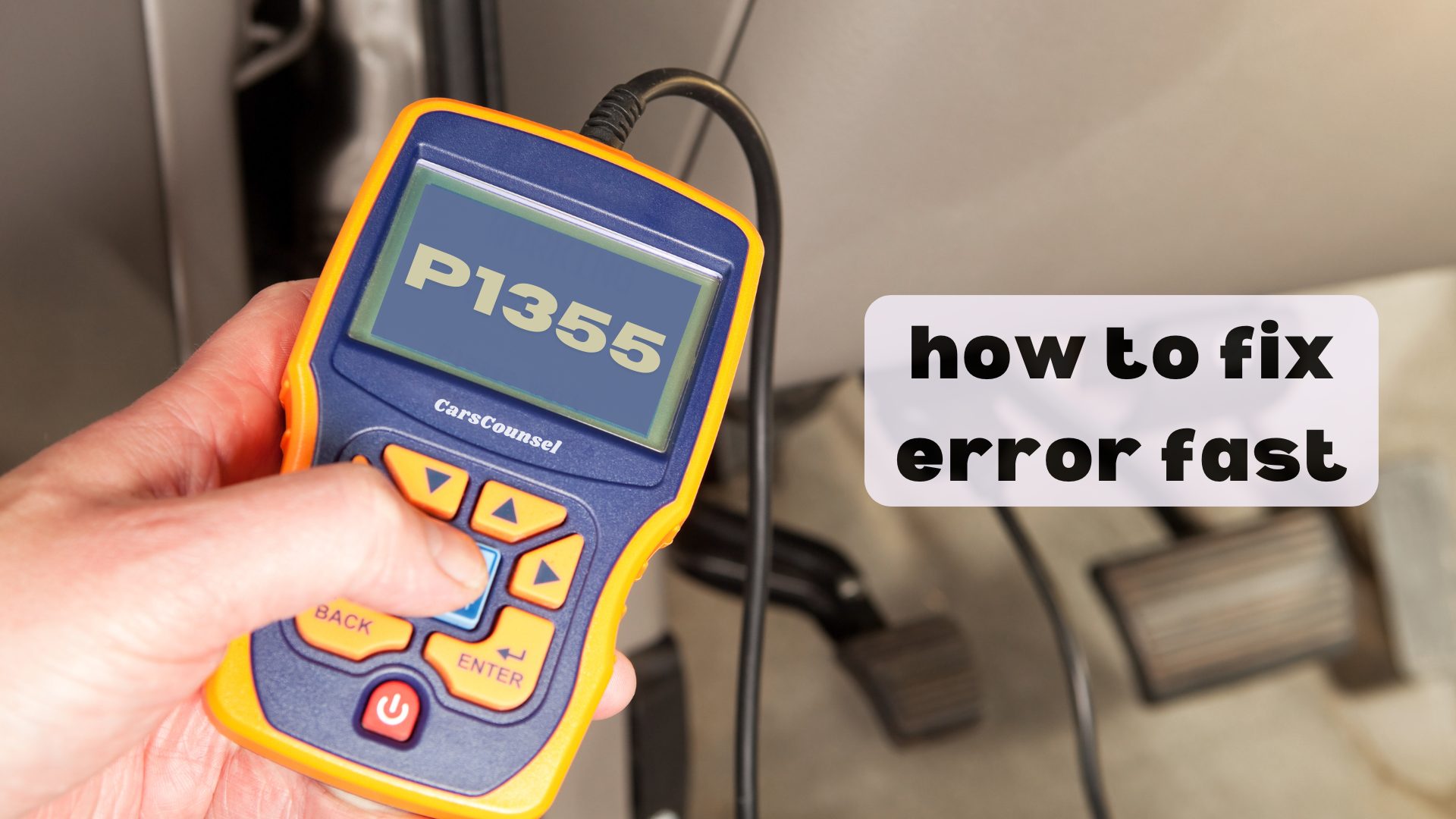As the spark that once fueled your engine’s performance begins to flicker, a warning sign flashes on your dashboard: the P1355 code. This code is like a red flag waving in the darkness, signaling an open circuit in the ignition system that’s affecting cylinder 1.
You’re left wondering what’s causing the misfires, poor engine performance, and potential damage to your engine. Is it a faulty ignition coil, worn-out spark plug, or a more complex issue? The diagnosis is unclear, but one thing is certain – you need to get to the root of the problem before it’s too late.

Quick Navigation
Key Takeaways
- The P1355 code indicates an open circuit in the ignition system, affecting the spark plug in cylinder 1, leading to poor engine performance and potential damage.
- Common causes of the P1355 code include ignition coil failure, spark plug wear, damaged ignition wires, and poor electrical connections.
- Symptoms of ignition failure include engine sputtering, rough idling, misfires, stalling, poor fuel efficiency, and loss of power or acceleration.
- Diagnosing the open circuit requires a thorough circuit analysis, including spark testing, voltage checking, and resistance testing in the ignition circuit.
- Repairing the ignition system may involve replacing spark plugs, ignition coils, or ignition wires, and inspecting electrical connections for loose or corroded connections.
Code P1355 Description
When your vehicle’s onboard computer triggers the P1355 code, it’s indicating a malfunction in the ignition circuit of cylinder 1 in the engine.
This trouble code points to an open circuit in the ignition system, affecting the components responsible for delivering spark to the spark plug in cylinder 1.
The ignition system plays a vital role in the combustion process, and any disruption can lead to poor engine performance, misfires, and potentially engine damage if left unaddressed.
Ignition Circuit Failure can cause rough idling, loss of power, poor fuel efficiency, and engine stalling.
The Engine Performance Impact of this code can be significant, making it essential to address the issue promptly to prevent further damage.
Common Causes of Failure
Since the P1355 code indicates an open circuit in the ignition system, it’s necessary to identify the root cause of the problem.
You’ll need to investigate the components responsible for delivering spark to the spark plug in cylinder 1. Common culprits include Ignition Coil Failure, which can prevent the spark plug from firing properly, and Spark Plug Wear, which can increase the voltage required to create a spark.
Damaged ignition wires, poor electrical connections, or issues with the engine control module (ECM) can also cause the open circuit. By pinpointing the faulty component, you can take the necessary steps to repair or replace it, ensuring your engine runs smoothly and efficiently.
Symptoms of Ignition Failure
As you’re experiencing issues with your engine, you’re likely wondering what symptoms to look out for that may indicate ignition failure.
Keep an eye out for engine sputtering, which can be a clear sign of spark plug wear or ignition circuit malfunction. You may also notice rough idling or misfires, especially when the engine is cold or under load.
If your engine is stalling frequently, it could be a sign that the ignition system is failing to provide a consistent spark. Additionally, poor fuel efficiency and loss of power or acceleration can also be indicative of ignition failure.
If you’re experiencing any of these symptoms, it’s essential to address the issue promptly to prevent further engine damage.
Diagnosing the Open Circuit
To diagnose the open circuit in your ignition system, you’ll need to pinpoint the faulty component causing the P1355 code. This requires a thorough circuit analysis to identify the root cause of the problem. Start by using a scan tool to retrieve trouble codes and monitor engine data. Then, perform ignition testing to check for spark, voltage, and resistance in the ignition circuit.
| Component | Testing Procedure |
|---|---|
| Ignition Coil | Check for spark output using a spark tester |
| Spark Plugs | Inspect for wear or fouling, and test for spark |
| Ignition Wires | Check for damage, corrosion, or high resistance |
| ECM | Monitor engine data and check for communication issues |
| Electrical Connections | Inspect for loose or corroded connections |
Repairing the Ignition System
With the faulty component identified, you can now proceed to repair the ignition system.
Start by performing a Spark Plug Replacement, as worn-out spark plugs are a common cause of the P1355 code. Inspect the ignition coil and ignition wires for signs of damage or wear, and replace them if necessary.
If issues persist, consider an Ignition System Overhaul to guarantee all components are functioning correctly. Check electrical connections and wiring related to the ignition system for loose connections or breaks, and repair or replace them as needed.
Once repairs are complete, clear the diagnostic trouble codes from the vehicle’s ECM using a scan tool and test drive the vehicle to confirm the repair has resolved the problem.
Cost of Repair and Replacement
You’ll need to budget for the necessary repairs to fix the P1355 code, which can vary depending on the extent of the damage and the type of components that need replacement.
Your repair estimates will depend on the specific components that need to be replaced, as well as the shop rates in your area.
Some estimated costs to ponder:
- Ignition coil: $50-$200
- Spark plugs: $50-$100
- Ignition wires: $20-$50
Keep in mind that labor costs can range from $100 to $300, depending on the complexity of the repair and the shop rates.
Total repair costs can potentially amount to $200 to $500 or more.
Be sure to check local rates for a more accurate estimate.
Troubleshooting Tips and Resources
Now that you’ve established a budget for the necessary repairs, it’s time to get hands-on with troubleshooting the P1355 code. Before diving into the repair, verify you have a thorough understanding of the ignition system and its components. Ignition System Maintenance is vital to prevent future issues.
| Component | Action |
|---|---|
| Spark Plugs | Inspect and test for wear, replace if necessary |
| Ignition Wires | Check for damage or corrosion, repair or replace as needed |
| Ignition Coil | Test for proper function, replace if faulty |
| Electrical Connections | Inspect for loose connections, repair or replace wiring as needed |
When replacing spark plugs, follow the recommended replacement interval to prevent premature wear. Additionally, consider Spark Plug Replacement as a preventative measure to maintain peak engine performance. By following these troubleshooting tips, you’ll be well on your way to resolving the P1355 code and getting your vehicle back on the road.
Preventing Future Ignition Issues
Regular maintenance of your vehicle’s ignition system is crucial to preventing future issues and avoiding costly repairs down the line.
To keep your ignition system running smoothly, follow these tips:
- Replace spark plugs regularly: Worn-out spark plugs can lead to ignition issues. Check your owner’s manual for the recommended replacement interval.
- Inspect ignition wires and connections: Damaged or corroded ignition wires and connections can cause open circuits. Inspect them regularly and replace them if necessary.
- Check ignition coil condition: A faulty ignition coil can cause ignition issues. Check the coil for signs of wear or damage and replace it if necessary.
More OBD-II Codes
Frequently Asked Questions
Can a Faulty Oxygen Sensor Cause a P1355 Code to Appear?
You shouldn’t suspect a faulty oxygen sensor as the primary cause of a P1355 code, as it’s unrelated to sensor correlation or ignition timing; instead, focus on the ignition circuit components, like coils, spark plugs, and wires, to identify the open circuit issue.
Will a P1355 Code Trigger a “Service Engine Soon” Warning?
You’ll likely see a “service engine soon” warning if your vehicle’s onboard computer detects an ignition coil failure or spark plug issues, causing a faulty ignition circuit that triggers the warning light to alert you to the problem.
Can I Drive Safely With a P1355 Code Illuminated?
You’re driving on thin ice with a faulty ignition system, and a P1355 code is the first crack. It’s not safe to drive with an open circuit in cylinder 1, as misfires and stalling can occur, putting you and others at risk, so address the issue promptly.
Will a Tune-Up Resolve a P1355 Code Issue?
You’re wondering if a tune-up will resolve the issue, but it depends on the root cause; if it’s spark plug wear or ignition coil failure, a tune-up might help, but if the problem lies elsewhere, further diagnosis is needed to fix the open circuit.
Can a P1355 Code Be Caused by Low Battery Voltage?
As you probe the ignition circuit, consider the spark of life: voltage. A voltage drop can starve the ignition signal, causing the engine to misfire, and yes, a low battery voltage can be the culprit behind the P1355 code issue you’re facing.
Conclusion
You’ve got this far, now it’s time to put the pedal to the metal! By addressing the P1355 code, you’ll be revving up your engine’s performance, avoiding costly repairs, and steering clear of potential engine damage. Don’t let a faulty ignition system put the brakes on your ride – take control, diagnose, and repair. With the right tools and know-how, you’ll be shifting into high gear in no time!

